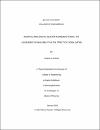INVESTIGATING SPATIAL QUALITY IN URBAN SETTINGS: THE ASSESSMENT OF WALKABILITY IN THE STREETS OF DOHA, QATAR
| Advisor | Mahgoub, Yasser |
| Advisor | Fadli, Fodil |
| Author | Alasadi, Rama |
| Available date | 2016-12-05T09:53:44Z |
| Publication Date | 2016 |
| Abstract | Walking is not the only most basic, but also the most prevalent form of transportation in cities. In the case of Doha, the capital city of Qatar, and the rapid development it is going through, urban planners are in need of an efficient user-friendly tool that would facilitate their objective in defining the quality of walkable areas and spaces. After investigating and reviewing several studies on the walkability issues, it was found that the majority of previous work in the field lack a comprehensive approach that combines qualitative and quantitative methods in measuring walkability. The purpose of this thesis is to investigate the factors that affect walkability in Doha and attempt to adopt and develop a Walkability Index Model (WIM) that will enable architects, urban planners and other decision makers to translate the perceptual qualities of streets, which are qualitative in nature, to a reliable quantitative value. To achieve this, the methodology of a previous study by Maryland Inventory of Urban Design Qualities (MIUDQ- 2006) was adopted. Based on the methodology adopted in this study and in order to gain the input required to develop the WIM, video footage of 30 streets across Doha were recorded and then rated by 10 professional experts in terms of walkability, and a set of selected urban design qualities. Physical features that proved to affect urban design qualities were counted offering a tangible input for the study. Finally several statistical computations were used to make sense of all the numbers proving that walkability is best perceived when all the selected urban design qualities were addressed. Legibility proved to be the most influential urban design quality on walkability followed by Coherence, Linkage, Human Scale, Imageability, Complexity, Enclosure, Tidiness and Transparency. The final product is an arithmetic equation that is integrated into a Microsoft Excel model to assess and compute the final score of walkability in the selected context. |
| Language | en |
| Subject | Urban Design Urban Planning Walkability Walkability Index Model (WIM) Architecture Area planning & development |
| Type | Master Thesis |
| Department | Urban Planning |
Files in this item
This item appears in the following Collection(s)
-
Architecture, Urban Planning and Design [38 items ]


